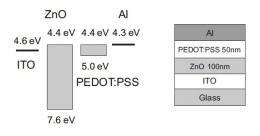The device structure and energy level diagram of the WORM memory, which can be programmed at power densities that are orders of magnitude lower than previously reported ultralow-power WORM devices. Image credit: Wang, et al. ©2010 American Institute of Physics.
(PhysOrg.com) -- As RFID tags are becoming more widespread for tracking and identifying almost anything, researchers are continuing to develop cheap, ultralow-power memory devices for these applications. In a recent study, scientists from Cambridge have taken another step forward in this area by developing a write-once-read-many-times (WORM) memory device that requires just a fraction of the power needed by previous devices. In principle, the low-power memory can be used in any organic electronic circuit where the operation power is low.
The researchers, Jianpu Wang, Feng Gao, and Neil Greenham from the Cavendish Laboratory at Cambridge, have published their study in a recent issue of Applied Physics Letters. As the scientists explain, RFID tags require a memory device that can be programmed and read using only the small amount of power taken from the radio frequency field. In addition to requiring a very low current consumption and operating voltage, disposable RFIDs also require memory devices that are inexpensive.
The Cambridge researchers’ WORM memory satisfies both these requirements. The electron-only design is fabricated by solution processing, making it less expensive than other techniques, such as those that require lithography. To write data, the device uses ZnO semiconductor nanoparticles to inject electrons into a conducting polymer. The injected electrons can be used to program the memory by permanently decreasing the conductivity of the polymer, producing an insulating state. The researchers demonstrated that the devices could be programmed at power densities of less than 0.1 W/cm2, which is orders of magnitude lower than previously reported ultralow-power WORM devices, which typically require at least 10 W/cm2.
The scientists explain that the low power of the devices is a consequence of the efficiency of the injected electrons in dedoping the previously doped polymer. The conducting polymer, called PEDOT:PSS, is already positively doped (with PSS), giving it a positive charge. When the electrons are injected by the nanoparticles, they dedope the polymer, reducing its conductivity.
“By using the wide bandgap ZnO nanoparticles, the electron-only device structure allows us to block the hole current,” Wang told PhysOrg.com. “Meanwhile, the injected electrons can dedope the PEDOT effectively, leading to an insulating state.”
Although the researchers are still investigating the details of the dedoping mechanism, their experiments show that water in the polymer film, which may be absorbed from the atmosphere, plays an important role in the dedoping process. In experiments performed under a nitrogen atmosphere, the low power density could not permanently change the polymer’s conductivity. The researchers also hope to make some further improvements to the device.
“The current structure still requires a thermal evaporation process to deposit metal electrodes,” Wang said. “Our ongoing research is to make an entirely solution-processed low-power WORM. We currently have some encouraging results on these extremely low-cost, low-power WORM devices.”
More information: Jianpu Wang, Feng Gao, and Neil C. Greenham. “Low-power write-once-read-many-times memory devices.” Applied Physics Letters 97, 053301 (2010). DOI:10.1063/1.3473775
Copyright 2010 PhysOrg.com.
All rights reserved. This material may not be published, broadcast, rewritten or redistributed in whole or part without the express written permission of PhysOrg.com.





















